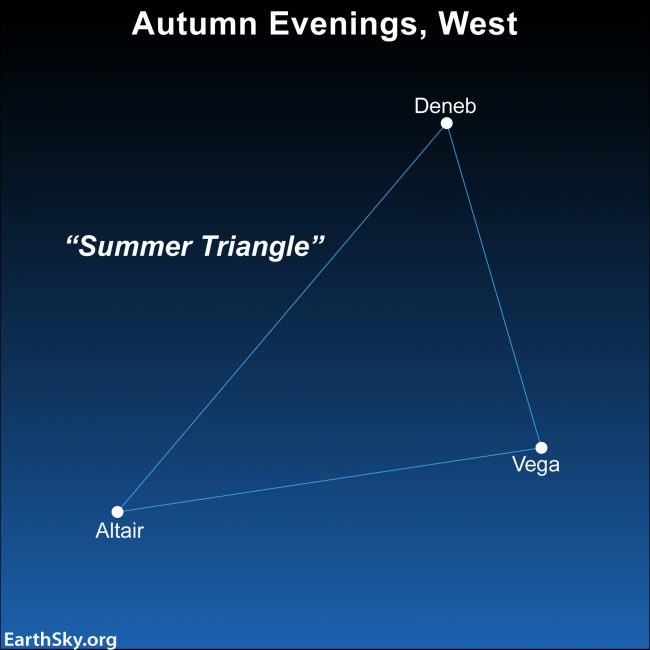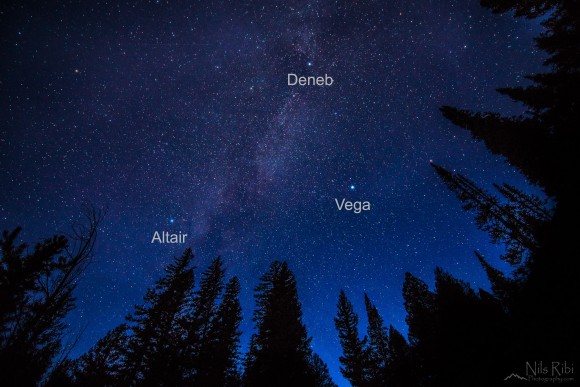
The Summer Triangle and its 3 stars
The Summer Triangle is the signature star formation in the Northern Hemisphere’s summer sky. But as the September equinox comes and goes – and as first weeks of autumn begin to slide by – you’ll still notice this famous asterism. Look for the Summer Triangle after dark in early November. It’ll continue to shine after dark through November and December, and even into January. Look for it tonight in early evening, high in your western sky.
The Summer Triangle isn’t a constellation. It consists of three bright stars in three separate constellations. The bright star Vega is in Lyra the Harp. Deneb is in Cygnus the Swan. And Altair is in Aquila the Eagle.
In the month of June – around the June solstice – the Summer Triangle pops out in the east as darkness falls and shines all night long. But now – in late November – the Summer Triangle appears way high in the west at evening. As evening deepens, the Summer Triangle descends westward, with all three of its stars staying above the horizon until mid-to-late evening.
Altair – the Summer Triangle’s most southerly star – will set around 10 to 11 p.m. tonight at mid-northern latitudes. Notice where you see the Summer Triangle at a given time this evening. The Summer Triangle will return to this same place in the sky some four minutes earlier with each passing day, or two hours earlier with each passing month.

Look for Orion, too
As the Summer Triangle sinks close to the western horizon around mid-evening, turn around to see Orion – the signpost constellation of winter – rising in the east.
Bottom line: Look westward this evening for the three brilliant stars of the humongous Summer Triangle: Vega, Deneb and Altair.
EarthSky astronomy kits are perfect for beginners. Order yours from the EarthSky store.
The post See the Summer Triangle in northern autumn first appeared on EarthSky.
from EarthSky https://ift.tt/3bAzp7Q

The Summer Triangle and its 3 stars
The Summer Triangle is the signature star formation in the Northern Hemisphere’s summer sky. But as the September equinox comes and goes – and as first weeks of autumn begin to slide by – you’ll still notice this famous asterism. Look for the Summer Triangle after dark in early November. It’ll continue to shine after dark through November and December, and even into January. Look for it tonight in early evening, high in your western sky.
The Summer Triangle isn’t a constellation. It consists of three bright stars in three separate constellations. The bright star Vega is in Lyra the Harp. Deneb is in Cygnus the Swan. And Altair is in Aquila the Eagle.
In the month of June – around the June solstice – the Summer Triangle pops out in the east as darkness falls and shines all night long. But now – in late November – the Summer Triangle appears way high in the west at evening. As evening deepens, the Summer Triangle descends westward, with all three of its stars staying above the horizon until mid-to-late evening.
Altair – the Summer Triangle’s most southerly star – will set around 10 to 11 p.m. tonight at mid-northern latitudes. Notice where you see the Summer Triangle at a given time this evening. The Summer Triangle will return to this same place in the sky some four minutes earlier with each passing day, or two hours earlier with each passing month.

Look for Orion, too
As the Summer Triangle sinks close to the western horizon around mid-evening, turn around to see Orion – the signpost constellation of winter – rising in the east.
Bottom line: Look westward this evening for the three brilliant stars of the humongous Summer Triangle: Vega, Deneb and Altair.
EarthSky astronomy kits are perfect for beginners. Order yours from the EarthSky store.
The post See the Summer Triangle in northern autumn first appeared on EarthSky.
from EarthSky https://ift.tt/3bAzp7Q

Aucun commentaire:
Enregistrer un commentaire